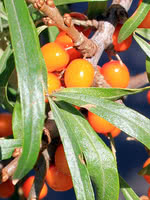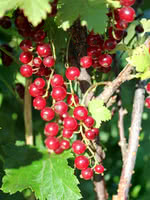Mon-Fri 9am - 5pm Mountain time
Sea Buckthorn (Seaberry) vs Red Currant
Hippophae rhamnoides l.
Ribes rubrum
NOT AVAILABLE THIS SEASON - MIGHT RETURN
Sea Buckthorn, aka Seaberry, is a nitrogen fixing shrub that produces attractive berries high in vitamin C.
While we can't confirm claims that the berries are effective in treating various ailments, many people believe consuming the berries helps with arthritis, infections, and asthma, among other things.
Sea Buckthorn plants have attractive pale silvery-green leaves, dense branches, and large thorns, people like to grow in ornamental hedges or as a first row in a shelterbelt.
Note: these plants typically reach maturity and make their sex easily known (females producing fruit) in their 3rd or 4th year of growth. Our seedlings are too young to identify their sex.
Red Currant is a deciduous shrub native to western Europe. It features five-lobed, maple-like leaves, and bright red berries that can be used in jams, sauces, and fresh eating.
Although this shrub is self-fertile, it will be more productive if another pollinator is present. For year over year high yields, ensure you fertilize (bone meal), prune, and mulch your Red Currant shrub.
Sea Buckthorn (Seaberry) Quick Facts
Red Currant Quick Facts
In row spacing: 0.9 - 1.2 m (3 - 4 ft)

